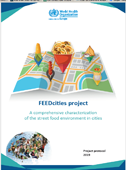FEEDcities project A comprehensive characterization of the street food environment in cities (2019)

Download
Project protocol
Introduction Ready-to-eat food sold in the street represents a global phenomenon, more common in urbanized areas, that constitutes an important dietary source in populations from low- and middle-income countries. However, research on the kind of street food offered and its composition is scarce. The main objective of this study is to characterize the urban street food environment, including vending places, the food offered, its nutritional composition, food purchasing patterns and advertising.
Methods and analysis This protocol provides a framework for a stepwise, standardized characterization of the street food environment; it consists of three steps that are of increasing complexity and demand increasingly great human and technical resources. Step 1 comprises identification of street food vending sites and characterization of the products available; this stage may be complemented with an evaluation of food advertising in the streets. Step 2 comprises description of street food purchasing patterns, by direct observation. Step 3 requires collection of food samples for bromatological analysis. Different levels of data collection may be defined for each step; hereafter, these are presented as core and expanded evaluations. For the most part, data analysis involves descriptive statistics and basic spatial analysis.
Ethics and dissemination This study was approved by the Ethics Committee of the Institute of Public Health of the University of Porto, Portugal. The research presents no risk to vendors or consumers, who will not be identified or identifiable through the information collected. Vendors will be kept informed and are free to refuse to collaborate. The findings of the study will be published on the World Health Organization (WHO) website as country reports, submitted for publication in international peer-reviewed journals, and presented at scientific meetings.



